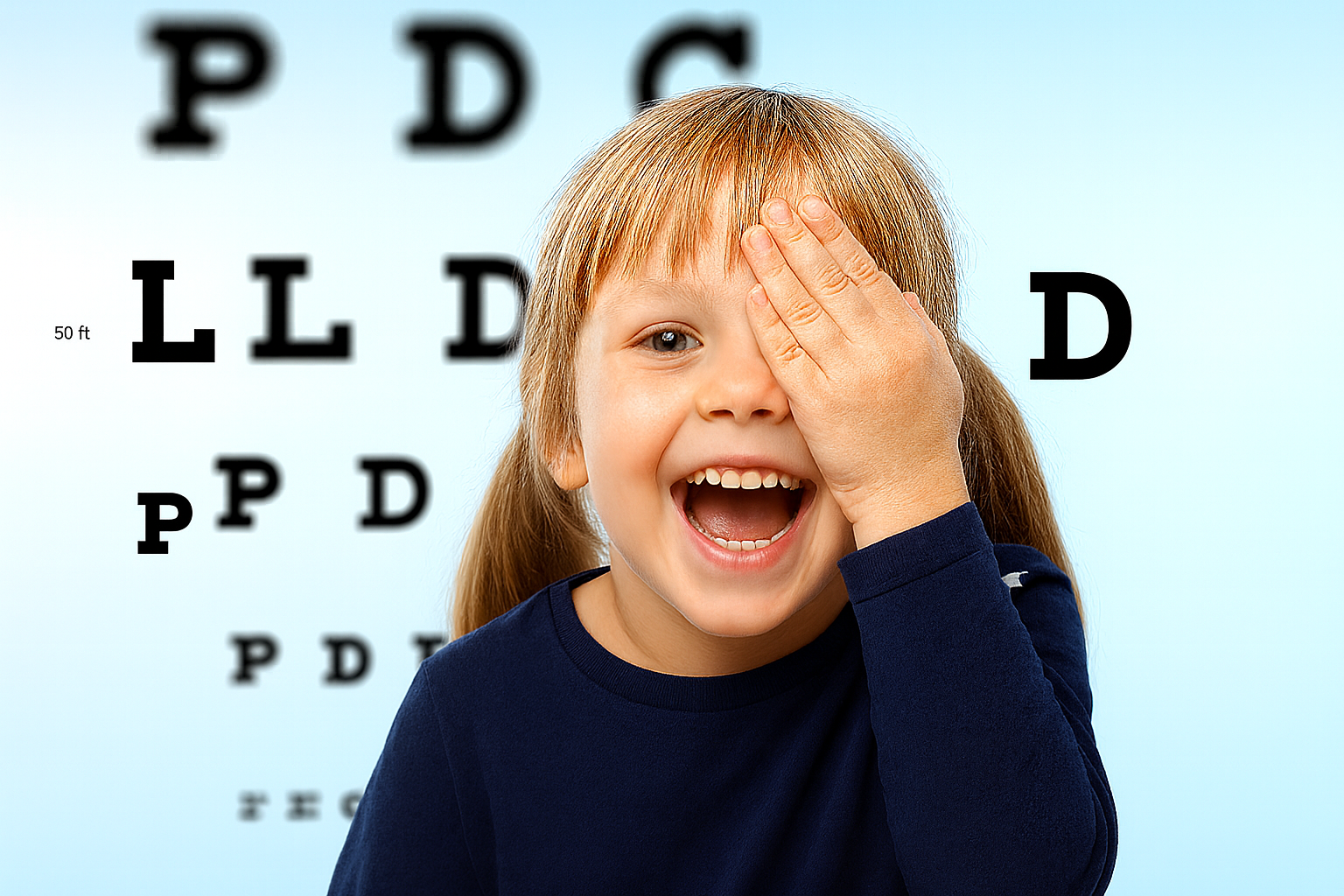What is CVI?
Cortical visual impairment is a neurological condition in which children with perfectly healthy eyes struggle – often significantly – with vision because the brain has difficulty processing visual information
There’s no clinical scan that can conclusively diagnose CVI, so diagnosis is made by an alignment of factors:
- An eye exam to confirm that the physical health of the eye cannot explain atypical visual behaviors
- A history of neurological impact or event which could have caused CVI (such as anoxic or hypoxic injury, infantile spasms, seizure disorder, stroke or IVH, etc.)
- The presence of atypical visual behaviors specific to CVI (which we’ll explore in-depth below).
Once a diagnosis is established (by an ophthalmologist, neuro-ophthalmologist, or neurologist familiar with CVI), it is important to obtain a functional vision assessment from a teacher of students with visual impairments (TVI). The functional vision assessment (FVA) will provide critical information about how the child uses their vision, and what supports are needed to make progress.
The clearest indicators of CVI are behavioral characteristics unique to children with CVI.
What are the signs of CVI?
There are ten characteristics typical of children with CVI. Understanding them in-depth helps parents and professionals identify CVI in children with vision challenges.
This guide was created with input from Chris Russell, a Teacher of the Visually Impaired committed to improving CVI identification. It will help you recognize the signs—and take the next step with confidence.
The characteristics are:
- Color preferences
- Need for or attraction to movement
- Visual latency (visual processing delay)
- Unique visual field preferences
- Difficulty with visual complexity
- Need for or attraction to light
- Difficulty with distance viewing
- Atypical visual reflexes
- Difficulty with visual novelty
- Absence of visually guided reach
CVI is categorized by severity into three phases – with Phase I being the most severe impact on functional vision and Phase being the closest to typical visual behaviors. Traits are usually more pronounced in earlier phases and less obvious but still present in more subtle forms in later phases.
CVI characteristics across the phases
1. Strong color preference
Children with CVI have an easier time seeing bright, saturated colors (red, yellow, neon). Muted pastels, grays, or black-and-white objects are much harder – or impossible – for them to see.
A child may only respond to a single bold color — for example, always looking at red, but ignoring other colors.
The child will look at a wider variety of objects, but bright, saturated colors still stand out and act as a visual anchor.
Ways to help:
Offer utensils, cups, or toys in one bold, consistent color – like a bright red spoon or yellow towel to help with independent eating and handwashing.
2. Attraction to movement
Movement helps capture and hold the visual attention of children with CVI.
The child may only look at moving things, such as ceiling fans or cars driving by.
The child can look at nearby stationary objects, but movement still helps draw their attention to items farther away.
What you might notice:
Children with CVI may rock or shake their heads – habits easily misunderstood as sensory behavior – to create motion to help them see. They may also use their vision more while they’re moving, like in a stroller, wheelchair, or while walking.
Ways to help:
Move the item your child wants to see (especially if they’re moving their body when attempting to focus on it, indicating that they need movement to help them focus).
3. Difficult with visual latency
Children with CVI show a delay between when their eyes see something and when their brain processes the image.
Children may consistently experience latency – a processing delay.
Visual latency decreases and may only show up when the child is stressed, tired, or overstimulated.
Ways to help your child:
Allow extra time for your child to visually process, without adding auditory or tactile distractions.
4. Unique visual field preferences
Children with CVI may see best from a specific angle, such as only noticing things on the right, left, upper, lower, or central field of vision.
A child may rely on a single strong visual field, such as only noticing objects on the right side.
Children use more than one part of their visual field. As they progress with interventions, they often gain use of the side fields (right and left) first, then the upper field, and later the central field for objects directly in front of them. The lower field usually remains the most difficult, even as vision improves.
5. Visual complexity
Children with CVI have difficulty processing “busy” visual information. This can take several forms.
- Complexity of the Array: a scene with a variety of different objects and materials, such as a basket of toys or a busy display in a book or on a communication board
Ways to help your child:
Reduce the complexity of the array to help your child see an object, such as removing a specific toy and putting it against a plain surface. During mealtime, be cognizant of the number of things on the table and the busyness of the placemat.
- Complexity of the Target or Object: an individual object with multiple colors, patterns, or details.
- Complexity of the Sensory Environment (multisensory complexity): Bright lights, noise, temperature, or social activity can overwhelm visual processing. Fatigue, discomfort, or overstimulation may reduce vision even more.
- Complexity of Faces: Faces are inherently complex with various distinct features, and children with CVI struggle to orient toward a face.
Children will find it difficult – or impossible – to process faces and won’t make eye contact.
Children can orient (without eye contact) toward familiar faces, like parents and caregivers. With even more progress, they may also start to orient toward unfamiliar faces. Finally, the child will actually start to make eye contact.
6. Need for or attraction to light
Bright lights draw and sustain the vision of children with CVI.
A child with CVI will stare at lights or bright windows.
Light gazing will decrease, and may only surface when the child is overstimulated, tired, or in a very busy environment. Further still, light gazing will be rare, but they’ll always benefit from light to enhance their vision.
Ways to help your child:
Use light to highlight important objects, such as shining a flashlight on a toy. Teach skills, like recognizing words, on a backlit screen instead of paper.
What you may notice:
Children with CVI are often thought to be “light gazing,” when they stare into space or look past an object. Often, they’re “switching off” their vision and reducing the strain on the brain, to better engage their other senses, like listening or touch.
7. Difficulty with distance viewing
Children with CVI struggle to see items in the distance. They may be able to see targets in the distance only if they’re moving, bright, illuminated, or a specific color.
At its core, this challenge relates to complexity – the farther away something is, the more complex its background becomes.
Children may not notice objects beyond about 18 inches. They might detect something up to three feet away if it’s moving, reflective, or highly contrasted.
Vision extends to further distances. In Phase III, many children can see up to around 20 feet in simple settings. In complex environments, the usable distance is often shorter.
Ways to help your child:
Reduce the distance between your child and the object they need to see. In classrooms or busy spaces, position them closer to the item of interest, whether it’s a toy shelf or the teacher. Highlight distant items with light, color, or motion to make them more noticeable.
8. Atypical visual reflexes
Two natural blink reflexes — blinking in reaction to touch between the eyebrows or to something moving quickly toward the face (blink to threat) — are affected in individuals with CVI.
The reflexes will be absent.
They’ll be latent or delayed, and as the brain improves in processing visual information, they usually resolve – typically by the end of Phase II.
9. Difficulty with visual novelty
Children with CVI see familiar objects, toys, or environments more easily than new or unfamiliar ones. With familiar visual input — such as a person, toy, object, or environment they know well — they may appear to have better vision.
A child may use their vision almost entirely on familiar objects and environments, showing little visual response to anything new.
The child will look at a wider range of objects but may still struggle with new items in busy or complex settings.
Ways to help your child:
Repeatedly expose your child to new items so they become familiar over time, and introduce novelty gradually, one new toy, object, or place at a time.
10. Absence of or difficulty with visually guided reach
Children with CVI struggle to use their eyes and hands together. They may look at something, turn their gaze away, and then reach for it. Some may need to touch an object before picking it up, or be unable to look at an object while holding it.
Children are unable to use sight and touch simultaneously.
Children look at the item they want to reach for, look away, then reach. In Phase III, the difficulty mostly resolves, and surfaces only in very fine motor tasks or scenarios with high complexity.
Note: Children with motor challenges, such as cerebral palsy, may not be able to reach for items, but they will still display the core challenge: inability to be in tactile contact with an item or person while using vision. Pay attention to what helps your child — they may use their vision more effectively when someone is holding them, touching their hand, or when they’re in specific positions.


















.png)




.png)













